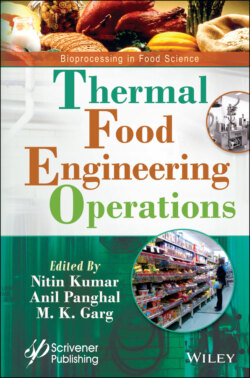Читать книгу Thermal Food Engineering Operations - NITIN KUMAR - Страница 19
1.3.1 Infrared Heating 1.3.1.1 Principal and Mechanism
ОглавлениеInfrared was discovered by William Herschel in the 1800s. Infrared depicted below red (infra: below); red is the longest wavelength of visible light. IR heating is the transmission of thermal energy in the form of electromagnetic waves. Wavelength between 0.7 and 1000 micrometer, wavelength larger than visible light but smaller than those of radio waves are the infrared waves. Three major types of infrared waves are [39]:
1 Short waves 0.76-2 μm (near IR waves), temperature above 1000°C
2 Medium waves: 2-4 μm (medium IR waves), when the temperature is above 400 - 1000°C
3 Long waves: 4-1000 μm (far IR waves), when the temperature is below 400°C
The working principle of infrared waves includes: IR energy is electromagnetic radiation emitted by hot objects (quartz lamb, quartz tubes, or metal body) by vibrations and rotation of molecules. When it is absorbed, the radiation provides up its energy to heat materials. An object is a “black-body”, if it absorbs (or emits) 100% of incident IR radiation. The quantity of heat emitted from a perfect radiator (blackbody) is expressed by Stefan-Boltzmann law equation:
Where Q is defined as the rate of heat emission, σSB is the Stefan-Boltzmann constant, T is defined as the absolute temperature, and A is defined as the surface area.
When radiant heaters and food products are not perfect absorbers, the Stefan-Boltzmann equation was modified and the concept of “grey body” was found:
Where ɛ defined as the emissivity of the grey body (ranging from 0 to 1).
This property changes with the wavelength of emitted radiation and temperature of the grey body.
The heating level depends on the absorbed energy, which then rely on the composition of food and the radiation frequency.
Mathematically, the transfer of heat rate to food is expressed as,
Where T1 depicts the temperature of the emitter and T2 depicts the temperature of the absorber. Heat transfer rate relies on:
1 Surface temperatures of heating and receiving bodies or materials,
2 Surface characteristics of both bodies or materials,
3 Shapes of the emitting and receiving materials.
Quantities indicate infrared radiations are the perfect source of energy for heating purposes. They indicate the factors such as larger heat transfer capacity, heat penetration directly into the product, no heating of surrounding air, and fast process control. A perfect balance required for optimal heating between the body and surface heating is attained with IR. The parameters that are important to control to achieve optimal heating results are radiator temperature, infrared penetration characteristics, radiator efficiency, and infrared reflection or absorption properties.
